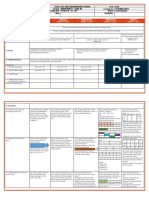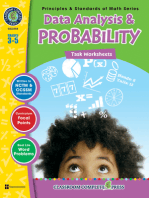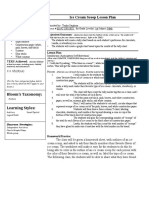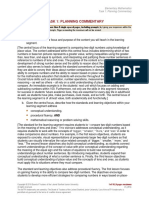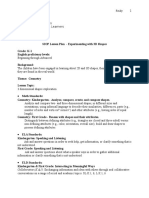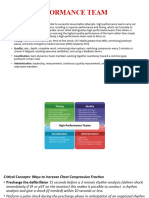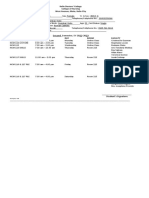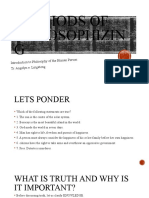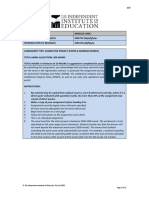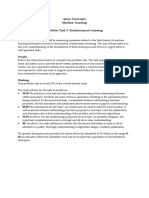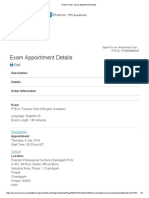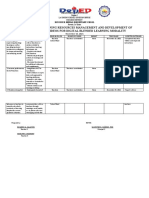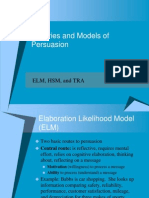Lesson Plan 2 Base Ten Blocks
Lesson Plan 2 Base Ten Blocks
Uploaded by
api-253732673Copyright:
Available Formats
Lesson Plan 2 Base Ten Blocks
Lesson Plan 2 Base Ten Blocks
Uploaded by
api-253732673Original Title
Copyright
Available Formats
Share this document
Did you find this document useful?
Is this content inappropriate?
Copyright:
Available Formats
Lesson Plan 2 Base Ten Blocks
Lesson Plan 2 Base Ten Blocks
Uploaded by
api-253732673Copyright:
Available Formats
Lesson Plan Model
1
Lesson Title/#: Adding and subtracting with base ten blocks
Grade Level: 2
Learning Central Focus
Central Focus
What is the central focus for the
content in the learning segment?
Students will be able to use prior knowledge of place value to solve addition and subtraction within 1000
Content Standard
What standard(s) are most
relevant to the learning goals?
Math.2.NBT.7: Add and subtract within 1,000, using concrete models or drawings and strategies based on place
value, properties of operations, and/or the relationship between addition and subtraction; relate the strategy to
a written method. Understand that in adding or subtracting three-digit numbers, one adds or subtracts
hundreds and hundreds, tens and tens, ones and ones; and sometimes it is necessary to compose or decompose
tens or hundreds.
Student Learning Goal(s)/
Objective(s)
Skills/procedures
What are the specific learning
goal(s) for student in this lesson?
Concepts and
reasoning/problem
solving/thinking/strategies
2
What are the specific learning
goal(s) for students in this lesson?
Students will be able to recognize flats as hundreds, rows as hundreds and units as ones
Students will be able to use these flats, rows, and units to help add and/or subtract within 1,000.
Students will be able to create problems of addition and/or subtraction.
Students will be able solve self-created problem of addition and/or subtraction using models.
Prior Academic
Knowledge and
Conceptions
What knowledge, skills, and
concepts must students already
know to be successful with this
lesson?
What prior knowledge and/or
Students must have prior knowledge of adding and subtracting with three-digit, and two-digit numbers.
Students must have prior knowledge of place value (ones, tens, hundreds)
1
The lesson plan template is intended to be used as a formative process prior to a candidates submission of edTPA materials. The template offers an opportunity for candidates to practice documenting their thinking
when planning lessons leading up to the learning segment they will teach for edTPA. Lesson plans with this level of detail are not necessary and should not be submitted as part of edTPA. It is intended to prepare
candidates to articulate their thinking and justification for plans when responding to the Planning Task commentary prompts
2
The prompt provided here should be modified to reflect subject specific aspects of learning. Language here is mathematics related. See candidate edTPA handbooks for the Making Good Choices resource for subject
specific components.
gaps in knowledge do these
students have that are necessary
to support the learning of the
skills and concepts for this lesson?
Instructional Strategies and Learning Tasks
Description of what the teacher (you) will be doing and/or what the students will be doing.
Launch
____1-2____
Minutes
How will you start
the lesson to engage
and motivate
students in learning?
Instructor will open lesson with review questions to activate prior knowledge and prompt student thinking. These review
questions will focus on addition problems with one digit, ten digit, and finally three digit. Students will be asked to explain
their answers.
Instruction
____10______
Minutes
What will you do to
engage students in
developing
understanding of the
lesson objective(s)?
How will you link
the new content
(skills and concepts)
to students prior
academic learning
and their
personal/cultural
and community
assets?
What will you say
and do? What
questions will you
ask?
How will you engage
students to help
Instructor will ask students what flats, rows, and units represent (hundreds, tens, and ones).
Instructor will prompt students to model three-digit addition and subtraction problems with their base ten blocks with
problems. Students will be able to use models of flats, rows, and dots to represent problems and solve them.
Instructor will ask questions throughout lesson such as, How many flats would (number) need? How many rows are in
a flat? How many dots in a row? Students must be able to use flats, rows, and dots to solve for self-created problems
with 80% accuracy.
them understand the
concepts?
What will students
do?
How will you
determine if
students are meeting
the intended
learning objectives?
Structured
Practice and
Application
____1-2______
Minutes
How will you give
students the
opportunity to
practice so you can
provide feedback?
How will students
apply what they
have learned?
How will you
determine if
students are meeting
the intended
learning objectives?
In pairs students will be working on addition and subtraction problems with base ten blocks and place value mats.
Instructor will provide questions for students to answer. They will use the blocks to represent their answer. Students
must complete self-created problems with 80% accuracy using models.
Closure
____1-2______
Minutes
How will you end the
lesson?
Instructor will review over concepts of flats, rows, and units used to model hundreds, tens, and ones. Instructor will ask
what model represents which place value.
Differentiation/ Whole Class: Students will be working individually and/or with partners (as instructor sees fit) to create three-digit
Planned
Support
How will you
provide students
access to learning
based on individual
and group needs?
How will you
support students
with gaps in the
prior knowledge that
is necessary to be
successful in this
lesson?
addition and/or subtraction problems. Must also work in groups to complete problems.
Groups of students with similar needs:
Students with similar needs will be assisted by instructor.
Individual students:
Individuals will be assisted by instructor and problems will be modified
Students with IEPs or 504 plans:
Students with similar needs will be assisted by instructor and be given extra time to complete work.
Student
Interactions
How will you
structure
opportunities for
students to work
with partners or in
groups? What
criteria will you use
when forming
groups?
Students will be working together in a pairs to represent three-digit addition and subtraction problems with base ten
blocks.
Theoretical
Principles
and/or
Research
Students will be using prior knowledge of basic arithmetic (addition, subtraction) and place value to regroup three digit
numbers with base ten blocks (ones, tens,hundreds)
Based Best
Practices
Why are the learning
tasks for this lesson
appropriate for your
students?
Materials
What materials does
the teacher need for
this lesson?
What materials do
the students need
for this lesson?
Paper (to work through problems)
Base ten blocks
Place Value Mat
Academic Language Demand(s):
What language function do you
want students to develop in this
lesson? What must students
understand in order to be
intellectually engaged in the
lesson?
Students will need to understand terms such as: hundred, ten, one, place, value, place value, addition,
add, subtraction, subtract
What content specific terms
(vocabulary) do students need to
support learning of the learning
objective for this lesson
Students will have to use academic language such as: hundred, ten, one
Students must understand difference between add (addition) and subtract (subtraction)
Students must understand difference between sum and difference
What specific way(s) will students
need to use language (reading,
writing, listening and/or
speaking) to participate in
learning tasks and demonstrate
their learning for this lesson?
Students will need to use academic language to be able to converse
Students will need to use academic language to be able to explain thought process when figuring out a
problem
What are your students abilities
with regard to the oral and written
language associated with this
lesson?
Students have already been introduced to academic language.
How will you support students so
they can understand and use the
language associated with the
language function and other
demands in meeting the learning
objectives of the lesson?
Instructor will begin lesson using academic language with explanations. Instructor will then phase out the
explanations and use exclusively the academic language (when instructor feels class is comfortable with
academic language).
Assessments:
Describe the tools/procedures that will be used in this lesson to monitor students learning of the lesson objective(s). Attach a copy of the assessment and the evaluation criteria/rubric in the
resources section at the end of the lesson plan.
Type of assessment
(Informal or Formal)
Description of assessment
(formative or summative)
Modifications to the assessment so
that all students could demonstrate
their learning.
Evaluation Criteria - What evidence of
student learning (related to the learning
objectives and central focus) does the
assessment provide?
Informal
Formative Student must complete work with
75% accuracy.
Student must complete work with 85%
accuracy.
Formal
Formative Student must be able to create three-
digit addition and/or subtraction
problems with 75% accuracy with
teacher assistance.
Student must be able to create three-digit
addition and/or subtraction problems with
85% accuracy.
Document adapted for original design by Deborah Layzell, Illinois State University
You might also like
- Toaz - Info Doctors Data Mix Department PRDocument168 pagesToaz - Info Doctors Data Mix Department PRKhushnandan K0% (1)
- The Cariboo CafeDocument3 pagesThe Cariboo CafeMyriam GGo0% (1)
- Parable of The Sower Teaching GuideDocument5 pagesParable of The Sower Teaching GuideAbrams Books100% (17)
- Task 2Document5 pagesTask 2api-708067647No ratings yet
- Edtpa Math Lesson Plans 3Document18 pagesEdtpa Math Lesson Plans 3api-270873656100% (3)
- Apple Math LessonDocument12 pagesApple Math Lessonapi-495904597No ratings yet
- Lesson Planning Template Edtpa 2021 2Document4 pagesLesson Planning Template Edtpa 2021 2api-548456048No ratings yet
- Lesson Plan Informational WritingDocument4 pagesLesson Plan Informational Writingapi-279823017100% (2)
- Edtpa Task 1 Part B - Plans For Learning SegmentDocument16 pagesEdtpa Task 1 Part B - Plans For Learning Segmentapi-302045878No ratings yet
- Lesson Plan 2Document4 pagesLesson Plan 2api-284370520No ratings yet
- Ted 410 Math LessonDocument9 pagesTed 410 Math Lessonapi-486956371No ratings yet
- Te 331 Math Lesson CinerDocument16 pagesTe 331 Math Lesson Cinerapi-494433412No ratings yet
- Math Lesson PlanDocument4 pagesMath Lesson Planapi-340862505No ratings yet
- Math Learning Segment (Task 4)Document2 pagesMath Learning Segment (Task 4)api-242665012No ratings yet
- Udl Math LessonDocument8 pagesUdl Math Lessonapi-273177580100% (1)
- Fall 2018 Edtpa Lesson Plan 2Document5 pagesFall 2018 Edtpa Lesson Plan 2api-327064630No ratings yet
- Teacher Work SampleDocument28 pagesTeacher Work Sampleapi-437973397No ratings yet
- Lesson Plan Retelling StoryDocument7 pagesLesson Plan Retelling Storyapi-542308733No ratings yet
- Grade 4 DLL Quarter 2 Week 9 (Sir Bien Cruz)Document38 pagesGrade 4 DLL Quarter 2 Week 9 (Sir Bien Cruz)FUMIKO SOPHIANo ratings yet
- Lesson Plan #2Document6 pagesLesson Plan #2Jason DonaldsonNo ratings yet
- Third Grade Math LessonDocument6 pagesThird Grade Math Lessonapi-591042996No ratings yet
- Math Lesson PlanDocument11 pagesMath Lesson Planapi-3142478620% (1)
- Edtpa Elementary Education Literacy - Context For LearningDocument3 pagesEdtpa Elementary Education Literacy - Context For Learningapi-299081358No ratings yet
- Unit Plan Math Lesson 3 of 6Document4 pagesUnit Plan Math Lesson 3 of 6api-193663371No ratings yet
- Lesson Plan LiteracyDocument4 pagesLesson Plan Literacyapi-570789490100% (1)
- Literacy Lesson PlanDocument4 pagesLiteracy Lesson Planapi-507074543No ratings yet
- Math LessonDocument8 pagesMath Lessonapi-464778396No ratings yet
- Lesson PlanDocument4 pagesLesson Planapi-512136633No ratings yet
- Ice Cream Scoop Lesson Plan: Bloom's TaxonomyDocument3 pagesIce Cream Scoop Lesson Plan: Bloom's Taxonomyapi-340127619No ratings yet
- Part A Math Context For Learning InformationDocument3 pagesPart A Math Context For Learning Informationapi-256550524No ratings yet
- edTPA-Task 1 Day 1Document2 pagesedTPA-Task 1 Day 1Chelsea Keeney100% (1)
- Observation 3 Math Lesson PlanDocument3 pagesObservation 3 Math Lesson Planapi-336922068No ratings yet
- Completed Math Approved Lesson PlanDocument8 pagesCompleted Math Approved Lesson Planapi-340175370No ratings yet
- Edtpa Lesson PlansDocument12 pagesEdtpa Lesson Plansapi-256801452No ratings yet
- Tayler Logue Math Lesson Plan - Grade 4Document4 pagesTayler Logue Math Lesson Plan - Grade 4api-373654763No ratings yet
- Mini Lesson Plan 7Document3 pagesMini Lesson Plan 7api-260889954100% (1)
- Edtpa Lesson PlansDocument12 pagesEdtpa Lesson Plansapi-34049548767% (3)
- Udl Lesson Plan Template Lesson 4Document4 pagesUdl Lesson Plan Template Lesson 4api-639552475No ratings yet
- Highlight Relevant Parts of The Standards That Relate Directly To Your Lesson ObjectivesDocument4 pagesHighlight Relevant Parts of The Standards That Relate Directly To Your Lesson Objectivesapi-283979987No ratings yet
- Tpa 3 - Assessing Student LearningDocument49 pagesTpa 3 - Assessing Student Learningapi-317738807100% (9)
- Math Lesson Plan ReflectionDocument8 pagesMath Lesson Plan Reflectionapi-338530955No ratings yet
- Unit Plan Math Lesson 4 of 6Document3 pagesUnit Plan Math Lesson 4 of 6api-193663371No ratings yet
- Edtpa Ell Planning CommentaryDocument7 pagesEdtpa Ell Planning Commentaryapi-439275675100% (1)
- Edtpa ResultsDocument7 pagesEdtpa Resultsapi-488212382No ratings yet
- ELD Levels/can Do Descriptors, Etc.) : This Lesson Is Intended For Use in A 9th Grade ELADocument18 pagesELD Levels/can Do Descriptors, Etc.) : This Lesson Is Intended For Use in A 9th Grade ELADanahNo ratings yet
- Math Lesson 1Document4 pagesMath Lesson 1api-249091828No ratings yet
- Medaille College Department of Education Lesson PlanDocument8 pagesMedaille College Department of Education Lesson Planapi-518686309100% (1)
- Teacher Work Sample 1 1Document44 pagesTeacher Work Sample 1 1api-248637452No ratings yet
- Sse Final Lesson Plan-DominiqueDocument5 pagesSse Final Lesson Plan-Dominiqueapi-313615727No ratings yet
- Formal Lesson Plan Math Lesson 25Document4 pagesFormal Lesson Plan Math Lesson 25api-303421137100% (1)
- Lesson Plan For Observation On 2-10-16Document10 pagesLesson Plan For Observation On 2-10-16api-320426519No ratings yet
- Lesson PlanDocument7 pagesLesson Planapi-317738807No ratings yet
- Part e - Planning CommentaryDocument10 pagesPart e - Planning Commentaryapi-446884620100% (1)
- Cep Lesson Plan TemplateDocument12 pagesCep Lesson Plan Templateapi-557959565No ratings yet
- Assessment - SIOP Lesson Plan Final - ReidyDocument7 pagesAssessment - SIOP Lesson Plan Final - ReidyGinaNo ratings yet
- Studentteaching Ela Edtpa LessonplanDocument8 pagesStudentteaching Ela Edtpa Lessonplanapi-301667326No ratings yet
- CISCEDocument1 pageCISCEjemuel.vedhNo ratings yet
- XI IIT IR FTM-03 24.07.2023 Key SolDocument9 pagesXI IIT IR FTM-03 24.07.2023 Key Soliitb.akkharcheNo ratings yet
- High Performance TeamDocument20 pagesHigh Performance Teamdrrosariff.putra100% (1)
- ArrraDocument2 pagesArrraMae Arra Gilbao Lecobu-anNo ratings yet
- The Language of Empathy - An Analysis of Its Constitution, Development, andDocument29 pagesThe Language of Empathy - An Analysis of Its Constitution, Development, andrustycarmelina108No ratings yet
- Methods of Philosophizing - Tr. AngieDocument25 pagesMethods of Philosophizing - Tr. AngieAngelyn Lingatong100% (1)
- Assignment 2 - Engaging With Grammar - Different Approaches - AssessmentDocument9 pagesAssignment 2 - Engaging With Grammar - Different Approaches - AssessmenthazemhazemjordanNo ratings yet
- INRS7321 - Summative AssignmentDocument13 pagesINRS7321 - Summative AssignmentLethokuhleNo ratings yet
- Cryoglobulin Qualitative Reflex IFE Typing and Quantitative IgA, IgG, IgMDocument2 pagesCryoglobulin Qualitative Reflex IFE Typing and Quantitative IgA, IgG, IgMTaieb AgourramNo ratings yet
- Aston University Machine Learning Portfolio Task 3: Reinforcement LearningDocument3 pagesAston University Machine Learning Portfolio Task 3: Reinforcement LearningprakashNo ratings yet
- Rancangan Pengajaran Harian: Daily Lesson PlanDocument2 pagesRancangan Pengajaran Harian: Daily Lesson PlanNordiana NordinNo ratings yet
- Teaching Epp/Tle/Tve/Tvl in The New Normal by Juanita G. AsuncionDocument3 pagesTeaching Epp/Tle/Tve/Tvl in The New Normal by Juanita G. AsuncionByron DizonNo ratings yet
- Chethankumara - My: Concentrix Daksh Services India PVT LTDDocument2 pagesChethankumara - My: Concentrix Daksh Services India PVT LTDDivya GowdaNo ratings yet
- Diorama RubricDocument1 pageDiorama RubricJeje NutNo ratings yet
- Second Round DME UG Allotment Result 2022Document106 pagesSecond Round DME UG Allotment Result 2022HisamNo ratings yet
- Amandeep KaurDocument6 pagesAmandeep Kauramandeep9895No ratings yet
- Picture-Book Unit Plan (Original)Document11 pagesPicture-Book Unit Plan (Original)api-266405967No ratings yet
- Itimes Investigating Semi-Supervised Time Series Classification Via Irregular Time SamplingDocument9 pagesItimes Investigating Semi-Supervised Time Series Classification Via Irregular Time Sampling刘绪鑫No ratings yet
- Learning Resource Management-SLACDocument5 pagesLearning Resource Management-SLACricardo salayonNo ratings yet
- Dissertation Genius ReviewsDocument4 pagesDissertation Genius ReviewsCustomWrittenPapersUK100% (1)
- Sacnasp: Applicants Academic RECORD (Must Be Aligned To University Academic Transcript/s)Document4 pagesSacnasp: Applicants Academic RECORD (Must Be Aligned To University Academic Transcript/s)Kondwani KNo ratings yet
- Theories and Models of Persuasion: Elm, HSM, and TraDocument22 pagesTheories and Models of Persuasion: Elm, HSM, and TraFernando MarquesNo ratings yet
- Life en Vol1 Eng PDFDocument125 pagesLife en Vol1 Eng PDFMr. Viki Modi GeneralNo ratings yet
- Teenage Is A Fundamental Stage of Life That Each Human Being Passes ThroughDocument4 pagesTeenage Is A Fundamental Stage of Life That Each Human Being Passes ThroughDineish MurugaiahNo ratings yet
- The Advocates Act.: First ScheduleDocument11 pagesThe Advocates Act.: First ScheduleNelson WalyawulaNo ratings yet
- MEDIATION - The Importance and Challenge of Active Listening in MediationDocument6 pagesMEDIATION - The Importance and Challenge of Active Listening in MediationacolumnofsmokeNo ratings yet


















